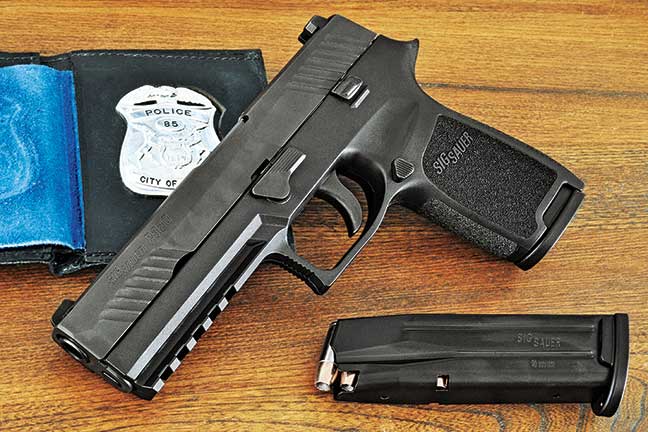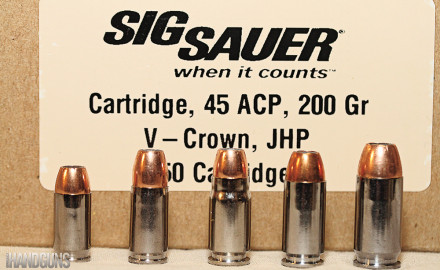Enjoy this very nice review of the new Sig Sauer P320 striker fired pistol from our friends at Handguns Magazine. The announcement of the SIG Sauer P320, ironically was what made me realize that—in an era where everybody is jumping on the striker-fired bandwagon—the company didn’t have a striker-fired pistol. The SIG Sauer P320 might look a little familiar. That’s because the new gun is basically a striker-fired version of SIG’s P250, a modular-framed double action/single action introduced several years ago.
The SIG Sauer P320 shares the grip, magazine and barrel of the P250. Currently, SIG offers full-size and compact versions of the P320, in both 9mm and .40 S&W, with .357 SIG versions on the way. For testing I received a full-size version in 9mm.
The SIG Sauer P320 is a modular gun in that the frame isn’t really a frame. The serialized frame is actually a stainless steel chassis inside the polymer grip module. The serial number is visible through a window in the plastic on the right side of the grip. SIG offers full-size and compact grip modules with small, medium and large grip sizes. Technically, it is possible to switch the serialized chassis between guns chambered in 9mm, .40 S&W and .357 SIG, but I can’t see anyone but police departments and SIG fanboys buying all those spare components. Want to know which grip your pistol is equipped with? It will be marked on the right side of the frame above the accessory rail and on the butt. Mine was marked “Full Medium”—meaning full-size grip frame, medium size grip.
SIG Sauer brought the P320 striker-fired pistol to market—aimed squarely at the duty-gun segment.
The full-size SIG Sauer P320 has a 4.7-inch barrel, weighs 29.4 ounces with an unloaded magazine in place and has a 17+1 capacity in 9mm (14+1 in .40). The compact version features a 3.9-inch barrel and a shorter grip that sacrifices about two rounds, depending on caliber. The slide has SIG’s Nitron finish, and the pistol comes with two steel magazines from Mec-Gar.
The slide has traditional SIG lines, and I was pleased to see forward cocking serrations. Standard on all models of the P320 are Siglite night sights, which are steel sights with three-dot tritium inserts.
Going with the “simple is better” mantra, the SIG Sauer P320 has no controls other than an ambidextrous slide stop/release, takedown lever and magazine release. The triangular magazine release is reversible, with easy-to-follow instructions in the owner’s manual. I found the triangular mag release to be surprisingly ergonomic.
There’s fine texturing on the front, back and both sides of the frame. It may not look like much, but appearances are deceiving. It is actually far more aggressive and grippy than it looks. This is the same kind of texturing found on the P250 and P290RS, and while at first I thought it was some kind of some kind of mechanical etching done after the molding process, I discovered it’s actually part of the molding. The detail is so small it’s hard to see with the naked eye, but those tiny edges are sharp.
I really like the trigger pull of the SIG Sauer P320 when compared to other striker-fired guns, but it’s not because of the weight, which SIG advertises as between 5.5 and 7.5 pounds. The pull on my sample measured 7.75 pounds, which is far too heavy for my taste. No, what I like is the length of pull. Total length of travel—including taking up the slack—was only 0.4 inch. Not counting the slack, actual trigger pull length (and reset) was only about a quarter of an inch. That is excellent.
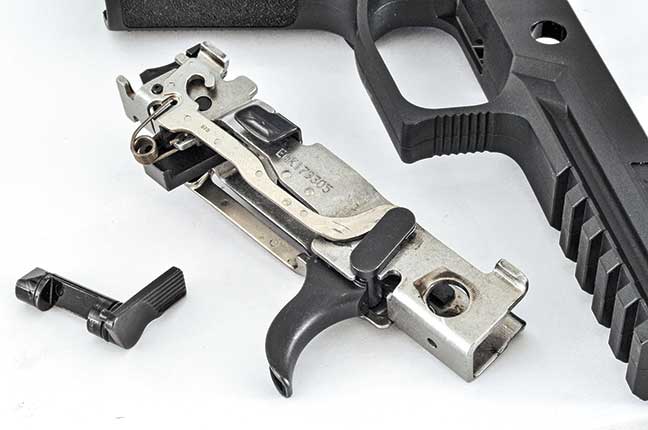
Like the P250, the SIG Sauer P320 uses a serialized steel chassis inside a polymer grip module, and the grip modules can be interchanged for different configurations (full size or compact) and sizes.
I spent a lot of time at my workbench with my NRA trigger pull weight set because I couldn’t believe the SIG Sauer P320’s trigger pull was that heavy. It felt like a six-pound pull. That’s because the pull was so short. A short trigger pull feels lighter than one of the same weight that is a lot longer, which is why overtravel stops exist.
A short length of pull means the sight picture will have less opportunity to be disturbed while the trigger is being pulled, and the shooter will be able to shoot quickly if necessary.
I also like that the trigger itself is steel. In fact, there is no polymer anywhere in the trigger mechanism. As a result of the metal-on-metal contact, the trigger pull is consistent. And being a striker-fired gun, if you are practicing your dry-firing, you’ll have to work the slide between each trigger pull to recock the striker. The pistol has no double-strike capability, although it will click every time you pull the trigger even if the striker is forward.
The striker on the SIG Sauer P320 is pre-cocked (SIG prefers the term “partially pre-tensioned”) inside the slide. A block cocks the striker as the slide runs forward, and pulling the trigger drops the block out of the way and allows the striker to move.
SIG says the striker is only partially pre-tensioned, but I think this is a bit disingenuous. The block holding the striker pivots at the front, so as it moves down it follows an arc and technically moves rearward slightly, thus pulling the striker backward the tiniest fraction of an inch.
Because of that nearly imperceptible rearward movement, the company can say the SIG Sauer P320 isn’t a single-action pistol. This is important because the number of police departments that authorize their officers to carry single-action pistols is miniscule. But for all intents and purposes, it’s a single-action gun; that’s why the trigger pull is so short.
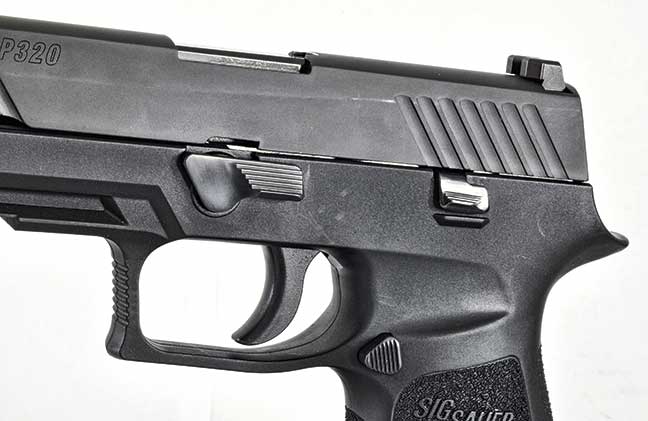
The company went the simplicity route with the SIG Sauer P320: takedown lever, ambidextrous slide release/lock lever and reversible magazine release.
The SIG Sauer P320 comes in SIG’s standard lockable case with cutouts for the two 17-round magazines and an injection-molded polymer paddle holster, which is a nice touch. The holster holds the SIG at a slight forward angle, and it has one tensioning screw below the trigger guard. Holsters like this are so cheap to make and provide such added value to the consumer I don’t know why every gun manufacturer doesn’t include one with its pistols.
Holsters designed for the P250 will fit the Sig Sauer P320 (in fact, the holster SIG provided with this pistol was marked “P250”). This will make it a lot easier to find holsters for this new gun than you might expect.
SIG is heavily promoting the P320’s “3-Point Take Down Safety System.” You have to remove the magazine and lock the slide to the rear before you can disassemble it, and disassembly doesn’t require pulling the trigger. That sets it apart from some other makes of striker-fired guns and also increases the safety factor for new (or relatively new) gun owners or officers who may have minimal safe gun-handling skills.
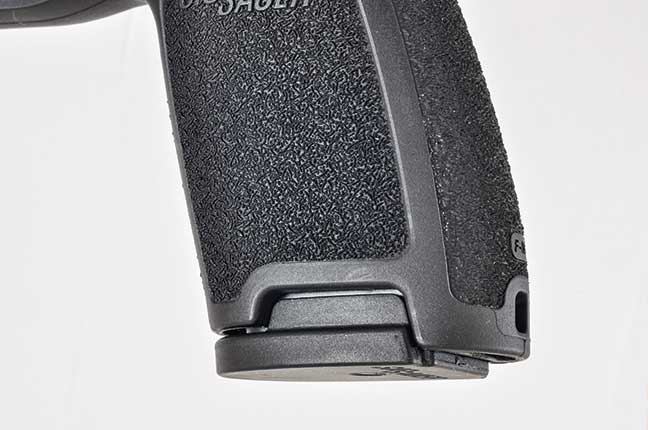
The molded-in texturing on the P320’s grip may look to be on the tame side, but it’s actually quite aggressive and does an excellent job of helping control the gun.
A SIG spokesman told Handguns that because some agencies believe a trigger-tab safety (a trigger with a safety lever on its face) or a thumb safety is a must, the company will make versions with those safeties available. However, these pistols will be for specific law enforcement contract orders. They will also be available overseas but not in the U.S. commercial market, at least not right away.
SIG’s all-metal guns can be a bit pricey, but at a suggested retail of only $713 for a full-size SIG Sauer P320 with night sights, this pistol will now be a contender for law enforcement agencies shopping for a striker-fired gun. And make no mistake: The P320 was built from day one as a duty gun because the company didn’t have a model that could be considered by agencies moving to striker guns.
And in addition to its mechanism, it has all the features an agency—or any person looking for a defensive pistol—needs or wants: a tactical rail, standard night sights, cutouts on the bottom of the frame so a reticent magazine can be stripped out and an oversize trigger guard.
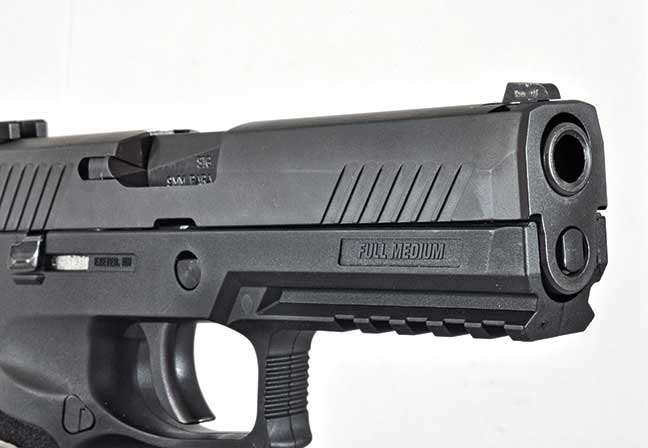
The slide is finished with Nitron for corrosion resistance, there’s an accessory rail (of course), and the Siglite night sights are steel—something the author really appreciates.
As for the gun’s aesthetics, I like the traditional SIG lines of the slide, but don’t like the clunky frame. But I didn’t like the P250, either. In my opinion, it is the rare polymer-framed pistol that isn’t ugly. That said, the P320 feels good in my hand and shoots well, which is the most important point.
Shooting full-size guns chambered in 9mm is usually pleasant, if not downright fun. The first chance I had to fire a SIG Sauer P320 was at a media event SIG hosted last January. I was able to whack steel out to 50 yards with ease. Both the P320 I shot there and the one I received for testing were accurate, reliable and easy to shoot quickly due to the short trigger pull.
The company has a promo video on the SIG Sauer P320 that states the pistol is “…more ergonomic and adaptable than any other pistol in its class.” While I like SIGs and can shoot this pistol well, I don’t agree with that statement. I think both the Glock and S&W M&P grips are more ergonomic, and being able to replace the SIG’s grip module with one of a different size isn’t the same (or better or more convenient) than having interchangeable backstraps.
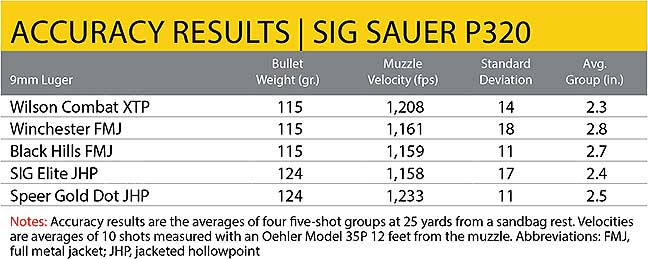
The lack of interchangeable backstraps on the SIG Sauer P320 may be a negative for both civilians and law enforcement. Yes, I know the pistol has a modular (replaceable) frame, but some departments will require a department “armorer” to do that because it requires disassembling the pistol beyond simple field-stripping—as opposed to just swapping out the backstraps. Various other striker-fired guns come complete with different sizes of backstraps, but you’d have to buy extra grip modules from SIG at $46 each.
I am a big fan of SIG pistols, and the announcement that SIG was putting out a striker-fired gun had me very excited. I had hoped SIG would take the opportunity to design something completely different for the firm, a pistol that didn’t feature the high bore offset SIGs are known for—because bores set high off the hand produce more felt recoil and muzzle rise.
Instead, the company opted to build a “FrankenSIG” out of existing P250 parts, and while it’s a clever piece of engineering, I think SIG missed an opportunity. The SIG Sauer P320 doesn’t feel bad in the hand, and it has a very good trigger for a striker-fired gun. Plus night sights come standard. There’s nothing wrong with what it is—other than I think it could’ve been so much more.
The post SIG Sauer P320 Review appeared first on Handguns.


